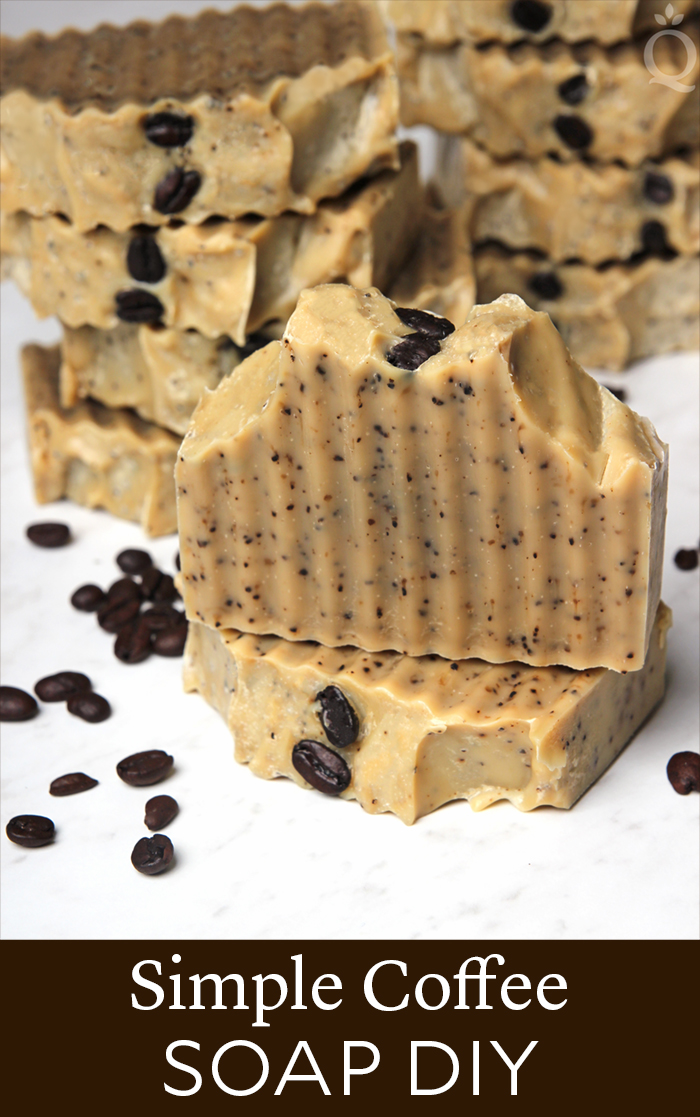
If you’re a coffee lover, this simple soap recipe is for you. It’s made with coffee seed oil, a dark and rich oil extracted from roasted coffee beans. Coffee seed oil has a delicious aroma. This recipe uses only 3% of it, but that’s enough to give it a light color and coffee scent.
The soap also contains used coffee grounds for exfoliation and coffee butter for extra moisture. Fresh grounds can bleed in soap, which is why used grounds are best. The liquid in this recipe is half distilled water and half brewed coffee. If you have never used coffee as the liquid in your soap before, check out our How to Make Coffee Soap post. Feel free to use all distilled water or all coffee if you prefer.
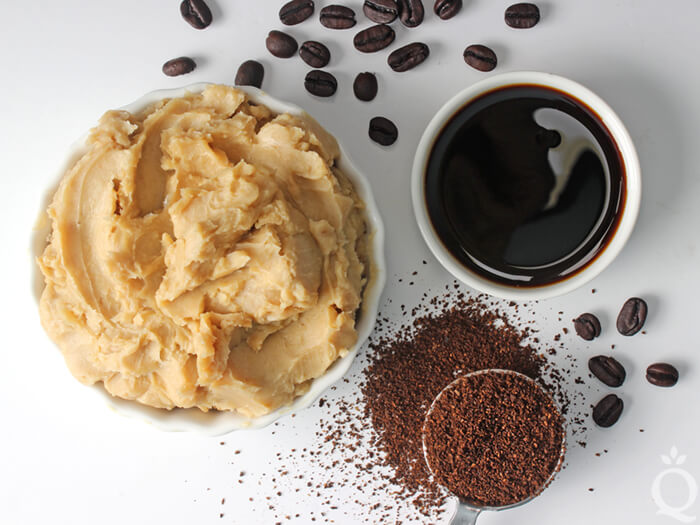
All these amazing coffee ingredients give the bars enough color and scent without any fragrance oil or colorant. That being said, the scent is very light. If you want a stronger coffee scent, Espresso Fragrance Oil would be great in this recipe. It will lightly discolor the soap.
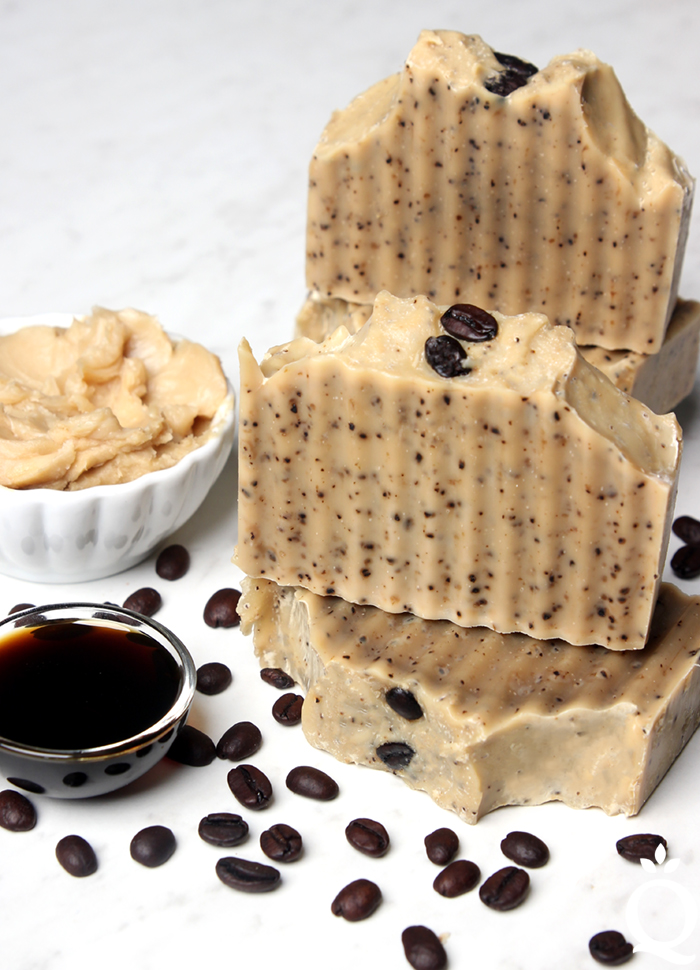
What You Need:
10″ Silicone Loaf Mold
13.9 oz. Olive Oil (42%)
8.3 oz. Coconut Oil (25%)
8.3 oz. Palm Oil (25%)
1.7 oz. Coffee Butter (5%)
1 oz. Coffee Oil (3%)
5 oz. Brewed Coffee
5 oz. Distilled Water
4.6 oz. Sodium Hydroxide Lye
2 Tbsp. Used Coffee Grounds
Whole Coffee Beans (for the top)
Optional: Crinkle Cutter

Click here to add everything you need for this project to your Bramble Berry shopping cart!
If you’ve never made Cold Process soap before, stop here! I highly recommend checking out our FREE four part SoapQueen.tv series on Cold Process Soapmaking, especially the episode on lye safety. And if you’d rather do some reading, Bramble Berry carries a wide range of books on the topic, including my newest book, Pure Soapmaking. You can also check out the digital downloads for that instant gratification factor.
SAFETY FIRST: Suit up for safe handling practices! That means goggles, gloves and long sleeves. Make sure kids, pets, and other distractions and tripping hazards are out of the house or don’t have access to your soapmaking space. Always soap in a well-ventilated area.
COFFEE LYE PREP: First, we need to prep the lye solution. For this project, we are using half coffee and half distilled water. Brew the coffee using distilled water. The strength of the coffee is up to you. The stronger it is, the darker your soap batter will be. In this recipe, we brewed enough coffee for the entire recipe (5 ounces) and used a “normal” strength, which resulted in a rich, dark color.
Measure 5 ounces of coffee into the container you use to mix the lye solution. Add 5 ounces of distilled water to the coffee, which needs to cool to room temperature or below before adding the lye. The colder the mixture is when the lye is added, the colder it will be after the lye is added.
Once your liquid is room temperature or below, slowly add the sodium hydroxide lye to the coffee and gently stir until the lye flakes are fully dissolved. The solution will start to darken and smell quite unpleasant. This is normal! Luckily, the scent goes away in the final bars.
ONE: Slowly and carefully add the lye to the water-coffee mixture, and gently stir until the lye has fully dissolved. Set aside to cool.
TWO: Fully melt and combine the coconut oil, palm oil, olive oil, coffee butter, and coffee oil. Remember to fully melt then mix your entire container of palm oil before portioning. Once the lye water and the oils have cooled to 130 degrees or below (and are ideally within 10 degrees of each other), add the lye water to the oils, and stick blend until it’s at a thin trace. If you’d like a harder bar of soap that releases faster from the mold, you can add sodium lactate to the cooled lye water. Use 1 teaspoon of sodium lactate per pound of oils. For this recipe, add 2 teaspoons sodium lactate. Stick blend the soap until it’s at a thin trace.
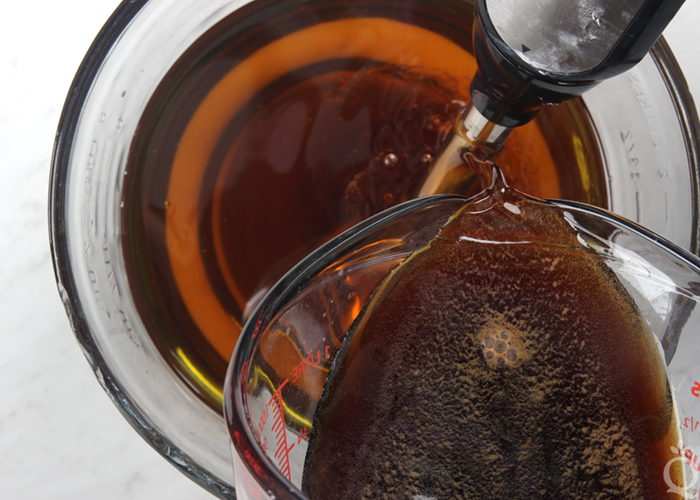
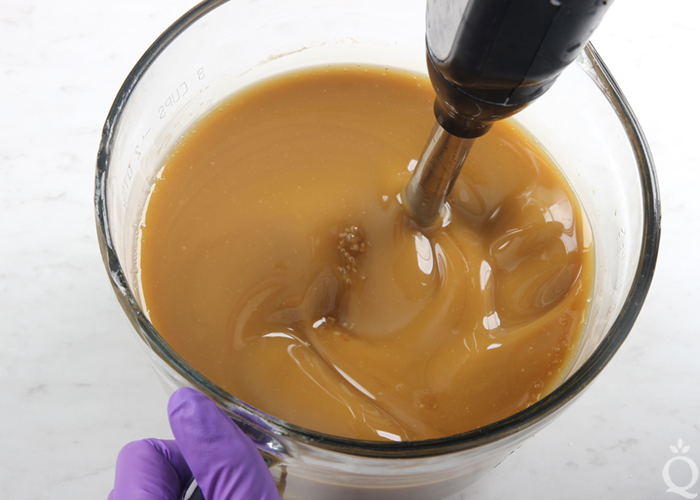
THREE: Continue to stick blend the soap until you reach a medium trace. Medium trace is perfect for suspending the coffee grounds and creating texture on top.
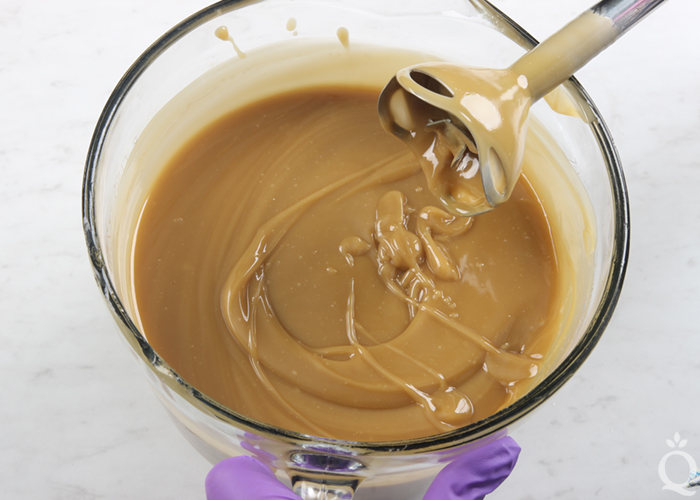
FOUR: Add 2 tablespoons of used coffee grounds to the soap batter and use a whisk to fully incorporate them.
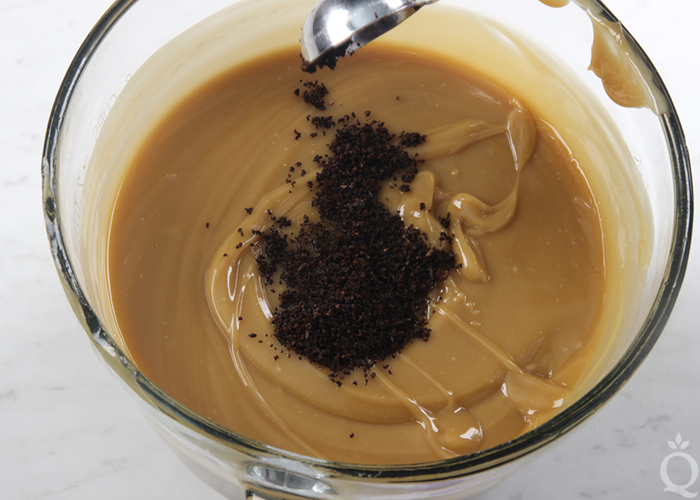
FIVE: Pour the soap batter into the mold. Tap the mold firmly on the counter to get rid of bubbles.
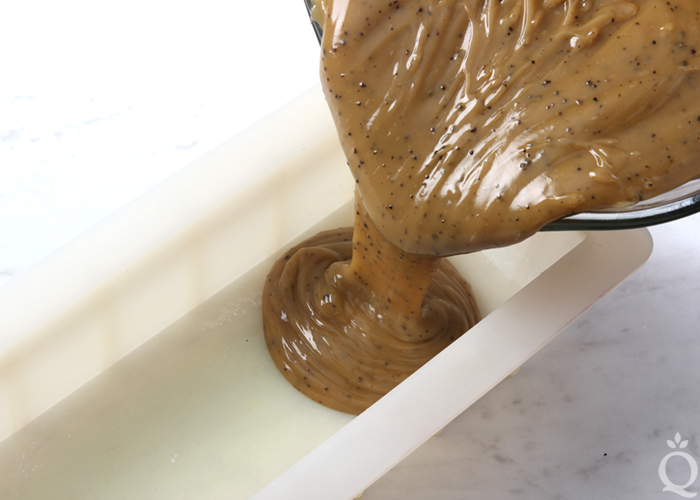
SIX: Use a spoon to mound the soap in the center and create texture. There is no right or wrong way to do this, so have fun with it!
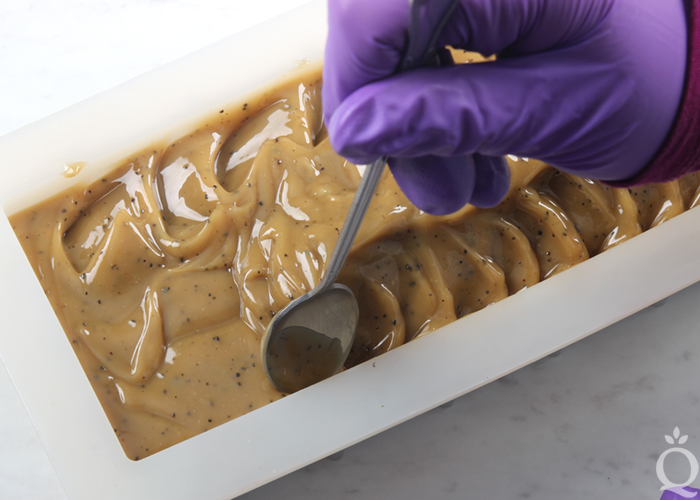
SEVEN: Place coffee beans in the center of the soap down the length of the mold. Gently pressing the beans into the soap will help them stick better. Once you’re happy with the look, spritz the top with 99% isopropyl alcohol to prevent soda ash. Allow the soap to stay in the mold for about two or three days. Unmold, and cut into bars. Use the Crinkle Cutter to achieve the textured cut shown here. Allow the bars to cure for four to six weeks, and enjoy!
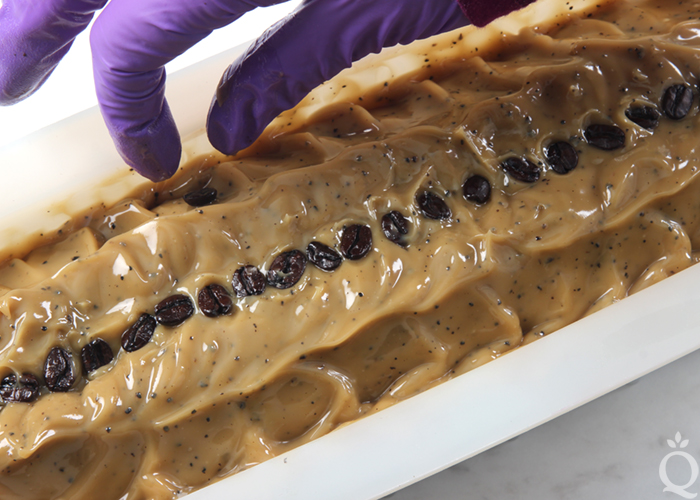
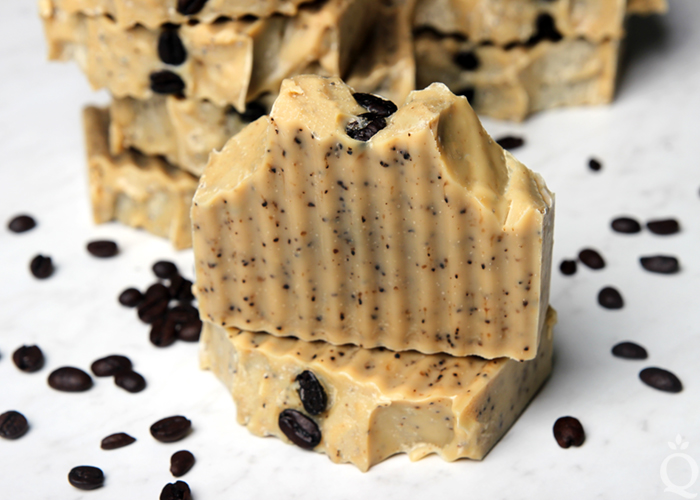
- 10″ Silicone Loaf Mold
- 13.9 oz. Olive Oil (42%)
- 8.3 oz. Coconut Oil (25%)
- 8.3 oz. Palm Oil (25%)
- 1.7 oz. Coffee Butter (5%)
- 1 oz. Coffee Oil (3%)
- 5 oz. Brewed Coffee
- 5 oz. Distilled Water
- 4.6 oz. Sodium Hydroxide Lye
- 2 Tbsp. Used Coffee Grounds
- Whole Coffee Beans (for the top)
- Optional: Crinkle Cutter
- Slowly and carefully add the lye to the water-coffee mixture, and gently stir until the lye has fully dissolved. Set aside to cool.
- Fully melt and combine the coconut oil, palm oil, olive oil, coffee butter, and coffee oil. Remember to fully melt then mix your entire container of palm oil before portioning. Once the lye water and the oils have cooled to 130 degrees or below (and are ideally within 10 degrees of each other), add the lye water to the oils, and stick blend until it’s at a thin trace. If you’d like a harder bar of soap that releases faster from the mold, you can add sodium lactate to the cooled lye water. Use 1 teaspoon of sodium lactate per pound of oils. For this recipe, add 2 teaspoons sodium lactate. Stick blend the soap until it’s at a thin trace.
- Continue to stick blend the soap until you reach a medium trace. Medium trace is perfect for suspending the coffee grounds and creating texture on top.
- Add 2 tablespoons of used coffee grounds to the soap batter and use a whisk to fully incorporate them.
- Pour the soap batter into the mold. Tap the mold firmly on the counter to get rid of bubbles.
- Use a spoon to mound the soap in the center and create texture. There is no right or wrong way to do this, so have fun with it!
- Place coffee beans in the center of the soap down the length of the mold. Gently pressing the beans into the soap will help them stick better. Once you’re happy with the look, spritz the top with 99% isopropyl alcohol to prevent soda ash. Allow the soap to stay in the mold for about two or three days. Unmold, and cut into bars. Use the Crinkle Cutter to achieve the textured cut shown here. Allow the bars to cure for four to six weeks, and enjoy!
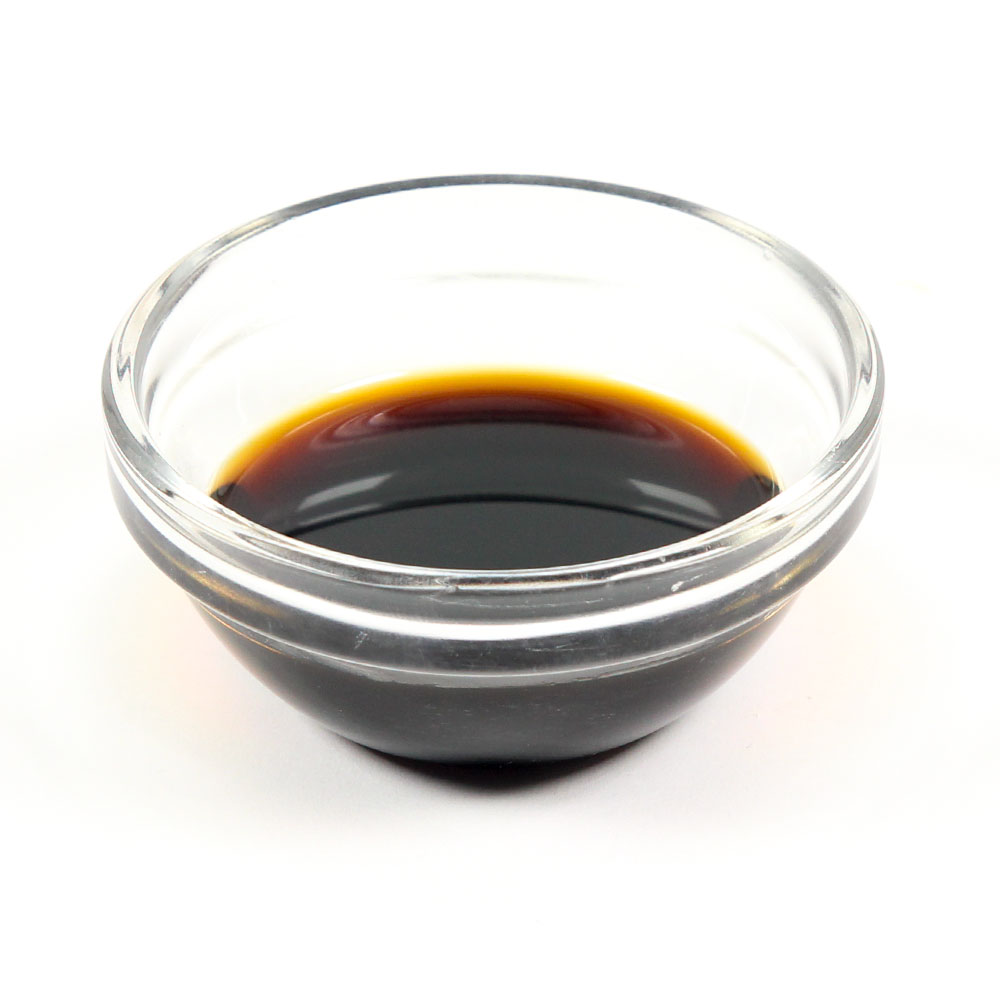
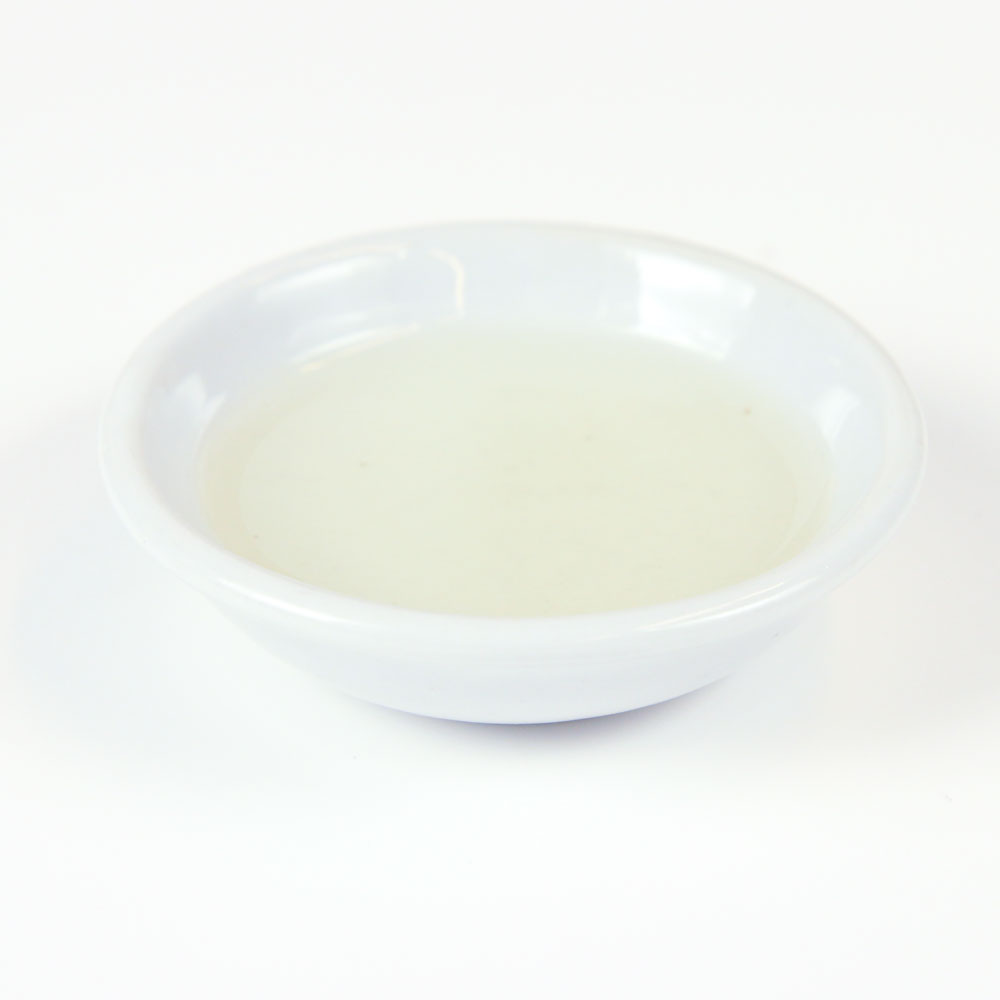
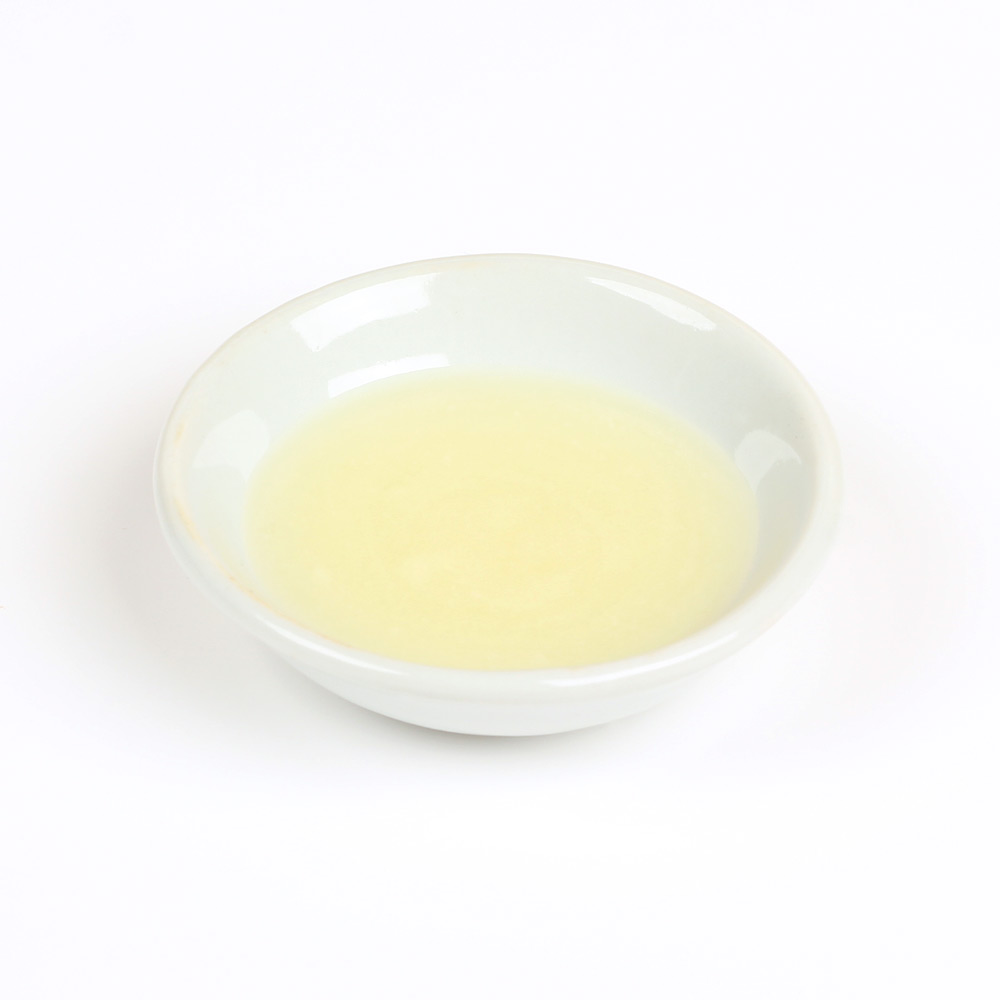
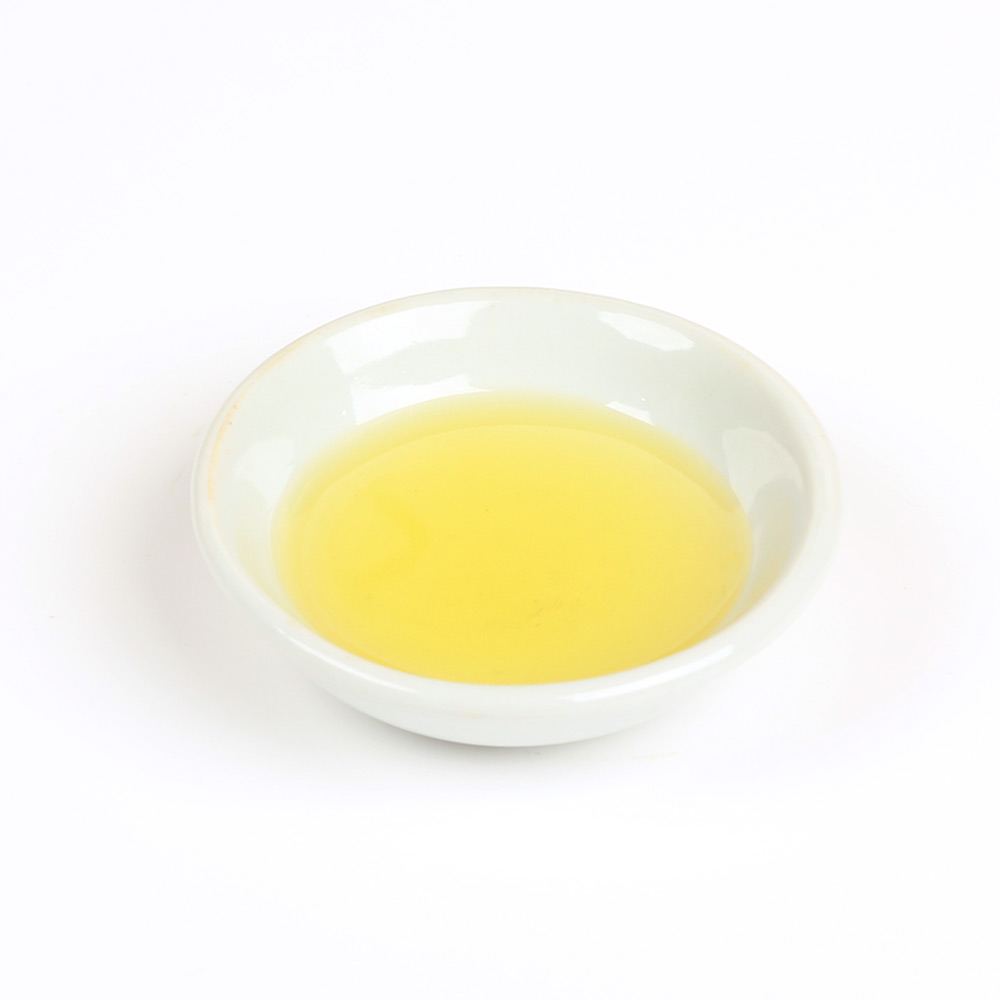
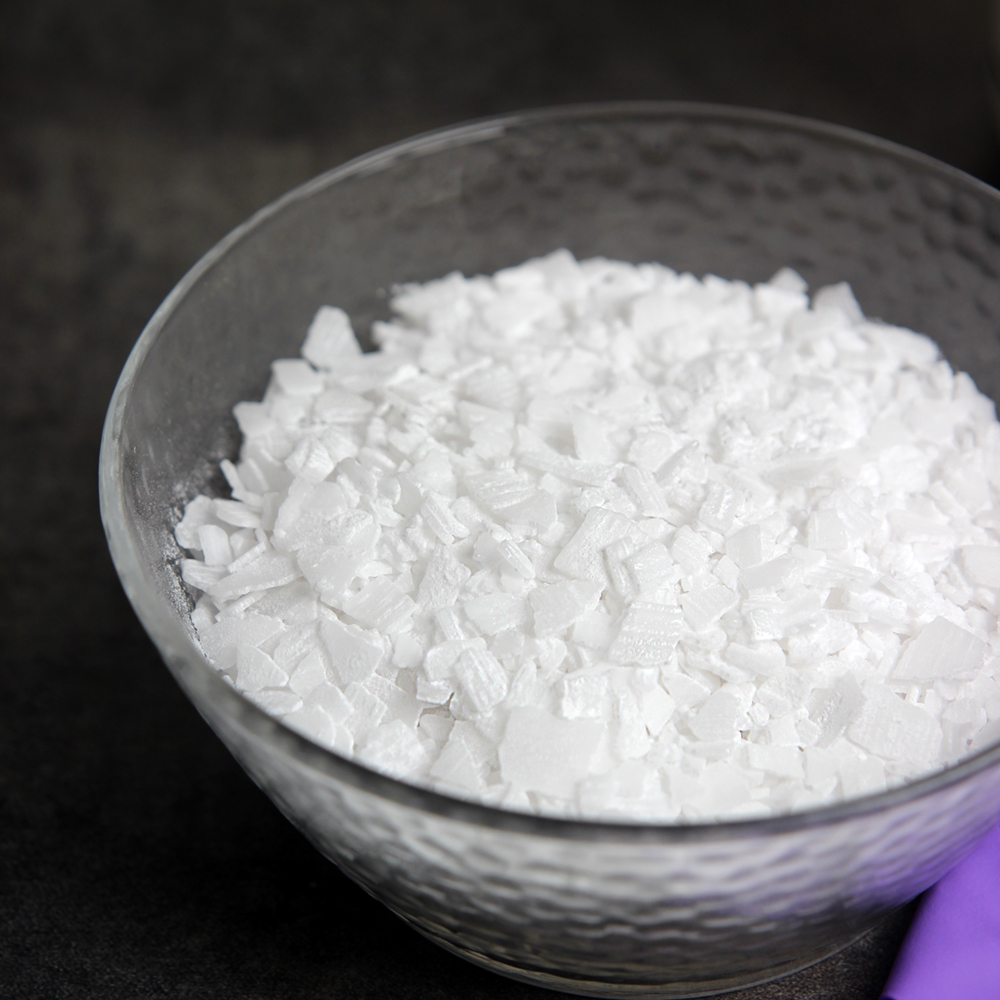
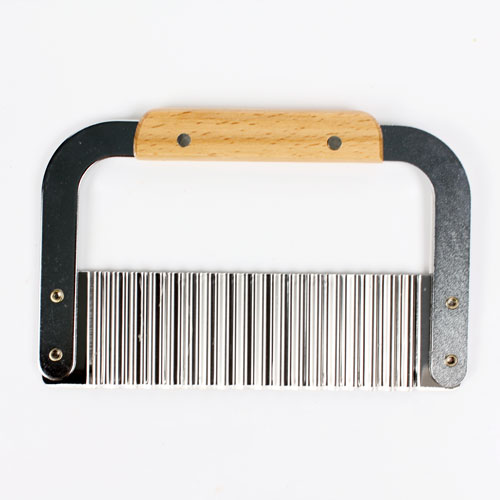
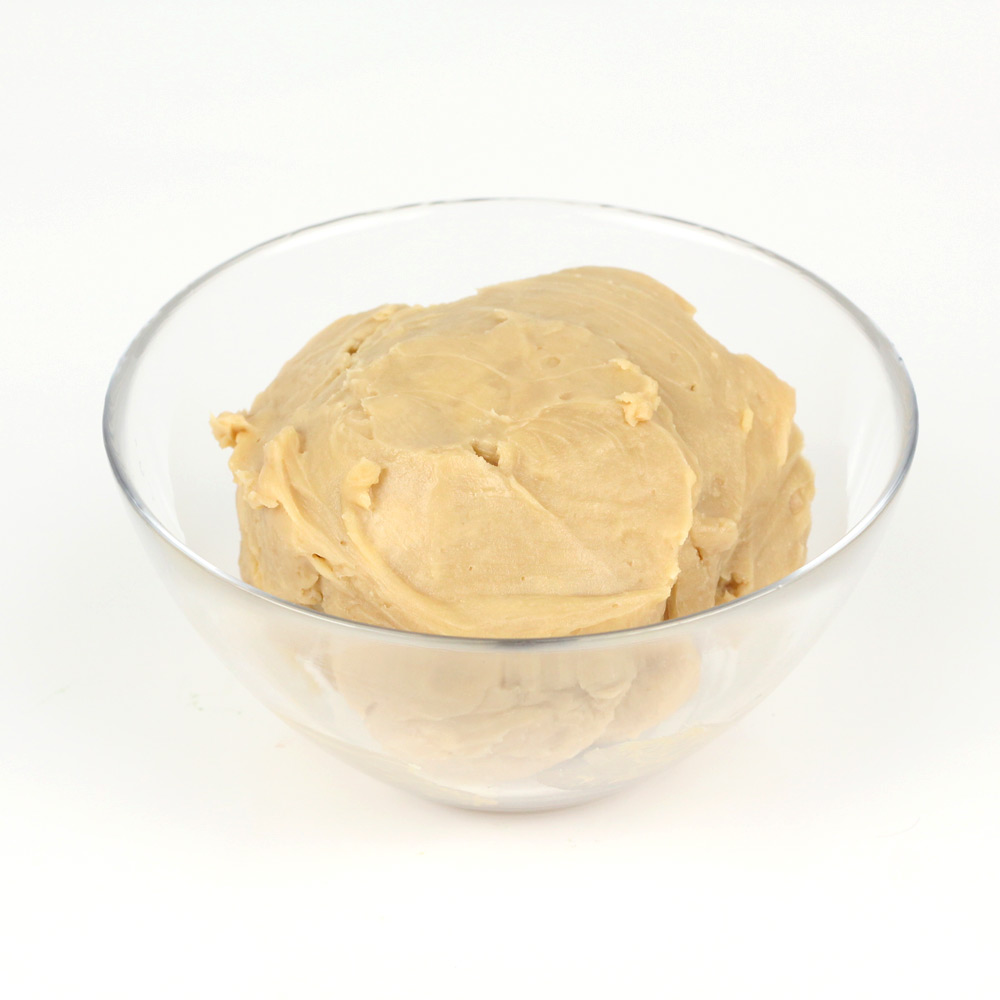


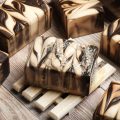
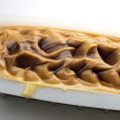
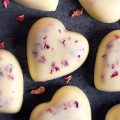
Hello, is there a percentage of superfatting in this recipe?
We work at 5% superfat.
I’d love to give this recipe a try and I have coffee butter but no coffee seed oil! Is it possible to maybe make a coffee infused oil and use that instead? Say, infuse the olive oil with coffee?
Sure you could definitely do that, though we haven’t tried that before so I am not sure how well it would eventually work!
I have few questions concerning this recipe. First, does the recipe need to be adjusted if I do not use the coffee grounds?
I would like to darken the color of the soap. Would the Bramble Berry Brown Oxide Pigment make a darker soap and if so, for this recipe, how much would I use?
I would like to put a spin on this soap recipe and call it “Coffee with cream” by layering or swirling the original colored soap with the darker colored soap (If I can darken with the brown oxide).
You do not need to adjust the recipe at all if you aren’t using the coffee grounds besides just not adding them. Brown Oxide would be perfect to add a darker color to the recipe, I would start at 1 teaspoon per pound of soap base. I think that sounds like a wonderful idea, if it turns out well send us some pictures!
Very Easy to follow. This was my 5th batch of soap and So far my favorite.. Thank You
Glad you like this tutorial. That means a lot to us!
Hello quick question should I melt my oils and then weigh them, or can it be done while the oils are still hard?
Thanks.
You can measure most of the oils while they’re hard. We often scoop the butter into the bowl and then melt everything together. However, palm oil needs to be fully melted and mixed in the bag before you add it to the bowl. If not, the fatty acid chains can get clumpy in the soap.
I’ve been looking into making a coffee soap. I’m it’s gettin into soap making and god your blog very helpful, but can you please make more palm oil free recipies or list other oils to use instead that won’t alter the recipient?
Babassu oil can be used in place of palm oil: https://www.brambleberry.com/Babassu-Oil–P6807.aspx
You can also add a hard oil like cocoa butter up to 15% to add firmness like palm oil does. Coconut oil or tallow up to 33% work as well. Read more about common oils and what properties they add to soap here: http://www.soapqueen.com/bath-and-body-tutorials/tips-and-tricks/free-beginners-guide-to-soapmaking-common-soapmaking-oils/
This post on substituting oils has some great information too: http://www.soapqueen.com/bath-and-body-tutorials/tips-and-tricks/how-to-substitute-oil-in-cold-process-recipes/
Looking fabulous! It’s gonna be my first try of making soap! I have a question regarding Coffee oil Is coffee seed oil the same as coffee essential oil? Thanks in advance.
No, they are different. Coffee seed oil is a carrier oil used to add moisture, while coffee essential oil is used for scent and added at a smaller usage rate.
If you have coffee essential oil, you can add it to this recipe to boost the scent. We recommend about 0.7 oz. per pound of soap, but you’ll want to check with the manufacturer to be sure of the usage rate.
This was my very first try at making soap and, although I learned many lessons, the soap did turn out alright! I would like to strengthen the scent (without using fragrance oil). If I used a very strongly brewed coffee substituting it entirely for the water and also used more coffee oil, would that improve the scent? Perhaps the coffee oil I used was not a good quality. As it is, after curing for a month, it smells faintly like burnt coffee. Thank you!
Increasingly the amount of coffee oil in the recipe will increase the amount of coffee scent. But, it may not give you a “sweet” coffee scent – we have found that coffee oil gives a very earthy coffee scent to soap. Unfortunately, coffee in place of water does not lead to a strong coffee scent in soap – the lye tends to kill it. Coffee oil will be your best bet!
Okay! I shall experiment. Thanks so much for your advice!
How do you recommend we handle gel? Try to prevent it by putting the soap in the refrigerator? Encourage it by insulating the soap? Or do neither – just leave it out and uninsulated? If it matters, I used a oval bar mold, rather than a loaf mold.
Thanks so much!
All the best,
Gwen
If the soap gels the color will likely be a bit darker. You can do that if you like. In an individual cavity mold it likely won’t gel, so leaving it out and insulated is fine. To be extra careful and prevent gel phase, pop it in the fridge.
Just to clarify, I made a small batch and used your 4″ silicone loaf mold and I insulated it for 24 hours. I have a big wet spot in the middle of the bars. Was I not to insulate it?
It sounds like you got partial gel phase. You can insulate your soap in this recipe if you would like it to go through gel, though sometimes that doesn’t fully happen. To make sure your soap is insulated enough to fully gel it helps to put it on a heating pad on the medium setting for 20-30 minutes while wrapped. After that time you can turn off the heating pad but leave the soap there and covered for 24 hours.
Learn more about When to Insulate Handmade Soap here: https://www.soapqueen.com/bath-and-body-tutorials/tips-and-tricks/when-to-insulate-handmade-soap/
Hi! How will I use a food grade lye (liquid) or can I use it on making soaps? thanks
Liquid lye is diluted with water – that means it can be tricky to use in our recipes. For instance, if our recipe calls for 10 ounces of lye, that means you need to figure out how much of the liquid lye to use to get 10 ounces of just lye, not the water it’s mixed with. I would recommend contacting the manufacturer to learn more.
Can you use lard in place of palm?
Yes, that will work in this recipe. Remember to run your recipe through the Lye Calculator after any substitutions: https://www.brambleberry.com/Pages/Lye-Calculator.aspx
The lard may feel a bit softer than the palm, so you may want to make a small test batch to see what you think. If it’s too soft for your preference you can add up to 33% coconut oil or add a butter like cocoa up to 15%.
Learn more in this post on substituting oils: http://www.soapqueen.com/bath-and-body-tutorials/tips-and-tricks/how-to-substitute-oil-in-cold-process-recipes/
Hi, i saw in your recipe, the lye and water is almost 50-50 ratio. Normally the water and lye should be how much? And in this recipe why is it so much?
Thanks!
This recipe calls for 5 ounces of coffee mixed with water, so you’re adding 10 ounces of liquid total. You can find the lye and liquid amounts using our Lye Calculator: https://www.brambleberry.com/Pages/Lye-Calculator.aspx
Hi, thank you so much for all that you share. I would like to use other oil than palm oil in this soap. What would you suggest? Thank you!
Babassu oil can be used in place of palm oil: https://www.brambleberry.com/Babassu-Oil–P6807.aspx
You can also add a hard oil like cocoa butter up to 15% to add firmness like palm oil does. Coconut oil or tallow up to 33% work as well. Read more about common oils and what properties they add to soap here: http://www.soapqueen.com/bath-and-body-tutorials/tips-and-tricks/free-beginners-guide-to-soapmaking-common-soapmaking-oils/
This post on substituting oils has some great information too: http://www.soapqueen.com/bath-and-body-tutorials/tips-and-tricks/how-to-substitute-oil-in-cold-process-recipes/
How could I use the 54 oz basic quick mix for this recipe? I need help with making it for my daughter’s wedding next May…
Yes, that Quick Mix will work just fine for this recipe. You’ll want to use 33 ounces for the 10″ Silicone Loaf Mold. You can find the amount of water and lye you need on the product page: https://www.brambleberry.com/basic-quick-mix-p5525.aspx
Really excited to try this as my first time making soap (eek! Yay!); I can’t wait for my ingredients arrive. Thank you for all the wonderful tutorials; I’ve been reading through them for a while now. I have a couple of equipment questions:
How big of a container will I need to have for making this batch of soap? (I have the mold already, just not a big container for mixing the lye-water and oils.)
What kind of thermometer do you recommend?
And finally, I purchased a well-made, nylon spoon (heat resistant up to 400 degrees F) to use while making the soap, but I should have done my homework first: is nylon a suitable material for a utensil in soap making?
Thank you so much!! 🙂
You’ll want a few containers for this recipe. For the lye, you’ll just need a small glass cup or mug. For the water, a 16 or 32 oz. Pyrex will work well. For the soap itself, a 5 quart glass bowl will work well. We like to use the big bowls that come with stand mixers. That way you have room to stir your soap.
5 Quart Glass Mixing Bowl: https://www.brambleberry.com/5-Quart-Glass-Mixing-Bowl-with-Lid-P5606.aspx
32 oz. Glass Measuring Cup: https://www.brambleberry.com/32-oz-Glass-Measuring-Cup-P6634.aspx
For the thermometer, you can use any one you like. We love this one because you can take the temperature easily throughout the process: https://www.brambleberry.com/Infrared-Thermometer-P6087.aspx
Also, that nylon spoon will work well. You can also use silicone, stainless steel, and heat-resistant plastic. You just want to avoid wood and aluminum spoons.
This post may be helpful for you, it has a list of tools you need to get started: https://www.soapqueen.com/bath-and-body-tutorials/tips-and-tricks/soapy-session-setup-guide/
Have fun and let us know how it goes. 🙂
I would like to make a 5 lb loaf.
You can resize this recipe easily with our Lye Calculator. Find out how in this post: https://www.soapqueen.com/bath-and-body-tutorials/tips-and-tricks/how-to-resize-cold-process-soap-recipes/
Hi, I just made this soap yesterday. i hope it smells better over time because right now it smells like burnt coffee which is not appealing. I wish I had added some coffee FO. I don’t think this will sell as is. That said. I like the idea of keeping it in the kitchen to take onion smell off hands. I do like the simplicity and ease of the recipe. Sometimes you just don’t want to swirl 🙂 Also, this is the first time I used sodium lactate to hardned the soap. Wow. It was ready to cut after 24hrs and almost too hard to use my wire soap cutter. Glad I did not wait the 2-3 days the recipe suggests.
When the soap is first made it will smell unpleasant – that’s normal. That smell goes away as it cures for 4-6 weeks. It will then have a subtle coffee scent that’s really nice. If you want a stronger coffee scent in your next batch, you can add Espresso Fragrance Oil.
Learn how much to add with our Fragrance Calculator: https://www.brambleberry.com/Pages/Fragrance-Calculator.aspx
Sorry if my question is silly. I’m new to soap making actually this soap will be the first I ever make. I was wondering does it smells like coffee already or I will need to add coffee fragrance? Thank you!
No worries, we’re happy to help. This is a great easy recipe to start with. The ingredients will lightly scent the soap. If you want a stronger coffee scent, Espresso Fragrance Oil would be great in this recipe. It will lightly discolor the soap.
Espresso Fragrance Oil: https://www.brambleberry.com/espresso-fragrance-oil-p5889.aspx
Find out how much to add with our Fragrance Calculator: https://www.brambleberry.com/Pages/Fragrance-Calculator.aspx
I’d like to make this recipe. As it will be my first attempt at making soap I’m wondering if it will create suds when finished. Thank you.
This soap has a nice creamy lather. If you like bigger, fluffier bubbles, you can add castor oil at 2-5% and reduce the olive oil to make up for the additional castor. That helps boost those bubbles.
Remember to run the recipe through the Lye Calculator again after any substitutions: https://www.brambleberry.com/Pages/Lye-Calculator.aspx
Learn more about common oils and what they add to soap here: http://www.soapqueen.com/bath-and-body-tutorials/tips-and-tricks/free-beginners-guide-to-soapmaking-common-soapmaking-oils/
This post has more on how to formulate cold process recipes: http://www.soapqueen.com/bath-and-body-tutorials/tips-and-tricks/formulating-cold-process-recipes/
-Kelsey with Bramble Berry
How do you choose your oils as far as the scent? because when you buy an oil one assume what the oil of their choice smell like, but unless one have a sample you really do not know. The reason I am asking is that I will be making soap I am only going to what others say. I would like to smell the oil before I buy the products. Can someone please give me some advise.
thanks
Marie in VA
We offer sniffy samples, that may be an option for you. A sniffy sample is an absorbent cotton strip dipped in fragrance and sealed in a mini Ziploc baggie. Find out how to get those samples here: https://www.brambleberry.com/Store-Policies-and-Shipping-Info-W11.aspx#Samples
We also offer free samples when you place an order, which allows you to try our fragrances. Learn about our sample program here: https://www.soapqueen.com/bramble-berry-news/new-sample-program/
-Kelsey with Bramble Berry
What can I use in place of the coffee butter?
Avocado or matcha green tea butter are good substitutes because they have a similar texture. Just remember to run that recipe through the Lye Calculator after any substitutions: https://www.brambleberry.com/Pages/Lye-Calculator.aspx
Avocado butter: https://www.brambleberry.com/Avocado-Butter-Solid-P3207.aspx
Matcha green tea butter: https://www.brambleberry.com/Matcha-Green-Tea-Butter-P6755.aspx
Read more about working with butter here: https://www.soapqueen.com/bath-and-body-tutorials/tips-and-tricks/all-about-butters-in-bath-beauty-products/
-Kelsey with Bramble Berry
HI! Love this website!! Getting ready to make this soap and was wondering what I can use to substitute for the coffee seed oil? Very hard to find and yours is not available. Can I just leave it out? Or can I use castor oil?
Thanks for your time.
There isn’t a direct substitute for the coffee seed oil, so I would recommend leaving it out. You can increase the olive oil by 3% to cover that coffee oil, just remember to run it through the Lye Calculator after any substitutions: https://www.brambleberry.com/Pages/Lye-Calculator.aspx
Also, the coffee oil adds color and a subtle scent to this recipe. If you prefer that, you can add a fragrance like Espresso and a brown color like Brown Oxide.
Espresso Fragrance Oil: https://www.brambleberry.com/Espresso-Fragrance-Oil-P5889.aspx
Brown Oxide: https://www.brambleberry.com/Brown-Oxide-Pigment-P4045.aspx
Learn how much scent to add with our Fragrance Calculator: https://www.brambleberry.com/Pages/Fragrance-Calculator.aspx
And learn more about how to work with color here: http://www.soapqueen.com/bath-and-body-tutorials/tips-and-tricks/talk-it-out-tuesday-colorants/
-Kelsey with Bramble Berry
Can I do this recipe with the lots of lather mix? How does the SAP value change with the coffee oil added?
You can make this soap with the Lots of Lather Mix, just remember to run it through the Lye Calculator to get the correct lye and liquid amounts: https://www.brambleberry.com/Pages/Lye-Calculator.aspx
For the coffee oil, that will need to be calculated as well. You can do that a few ways, the first being setting the superfat to 2% and adding the 3% coffee oil like a superfat. Or, you can run the 1 oz. of coffee oil through the Lye Calculator separately, then add that lye and water amount to your total lye and water.
-Kelsey with Bramble Berry
Lots of Lather Quick Mix: https://www.brambleberry.com/Lots-of-Lather-Quick-Mix-P5524.aspx
I use cp process but very moist, how can i do.?
To make the soap harder, it helps to add hard oils like coconut and palm up to 33%. Learn more in the Formulating Cold Process Recipes post: http://www.soapqueen.com/bath-and-body-tutorials/tips-and-tricks/formulating-cold-process-recipes/
It also helps to let the soap cure for 4-6 weeks. That creates a harder bar that lasts longer in the shower.
This post has more on making your soap last longer: https://www.soapqueen.com/bath-and-body-tutorials/tips-and-tricks/make-soap-last-longer-shower/
-Kelsey with Bramble Berry
Hi Team,
Request you to please provide me your feedback on my below CP soap recipe, hardness = 35, cleansing = 9 and conditioning = 63 on lye calc. Below are my ingredients with usage.
Olive oil – 45%
Shea Butter – 20%
Coconut Oil – 13%
Castor Oil – 4%
Cocoa Butter – 12%
Sunflower Oil / Almond Oil – 6%
SF – 5% .
I use Goat Milk in place of water, amt of which is 2 times that of Lye.
That looks like a great recipe. The shea, cocoa, and coconut will give the recipe firmness, and the other oils will provide moisture. Make sure to put the soap in the freezer for 24 hours. That way the soap won’t crack or scorch.
Learn more about working with milk here: http://www.soapqueen.com/bath-and-body-tutorials/tips-and-tricks/how-to-add-lye-to-milk-for-cold-process-soap/
-Kelsey with Bramble Berry
i make a soap similar to this one that we keep in the kitchen to remove onion odors from our hands.
Coffee grounds are so great for exfoliation!
-Kelsey with Bramble Berry
Should the coffee grounds be dry before adding it to the soap batter?
Yes, you’ll want to let the used grounds dry before using. That will prevent them from bleeding inside the soap.
-Kelsey with Bramble Berry
I have some strange spots on the sides and the bottom. Is that likely caused by damp coffee grounds? If so, it is only cosmetic, correct?
I’m not 100% sure. That could be discoloration from the grounds or DOS. It most likely is an aesthetic issue.
When adding the used coffee grounds, do you make sure the grounds are dry first?
You’ll want to let those used coffee grounds dry before use, otherwise they can form little circles of color around them. We’ve found spreading the used grounds out on a paper towel and letting them sit for a few hours does the trick.
-Kelsey with Bramble Berry
Looks great! Is coffee seed oil the same as coffee essential oil?
It isn’t – this coffee oil is a fixed oil, so it’s used to add moisturizing properties to your recipes. It does have a scent, but that’s not its main use. Coffee essential oil is used mainly for scent (and likely color). Learn more about the oil here: https://www.brambleberry.com/Coffee-Seed-Oil-P6748.aspx
-Kelsey with Bramble Berry
Hi.
To harden CP can you also use gycol? or that is only for glycerine soaps? should i only use sodium lactate?=
Sodium lactate works well, it helps harden the soap. You can add 1 teaspoon per pound of oils in your cool lye water. Learn more here: http://www.soapqueen.com/bramble-berry-news/sunday-night-spotlight-sodium-lactate/
If you don’t have sodium lactate, you can make a salt water solution. To make the solution, mix 1 teaspoon of regular table salt into 1 ounce (by weight) of warm distilled water. Stir until the salt is fully dissolved. We recommend 1 teaspoon of salt in 1 ounce of water per pound of soap. Make sure to discount the salt water solution from your liquid amount. Then, add the solution at trace.
-Kelsey with Bramble Berry